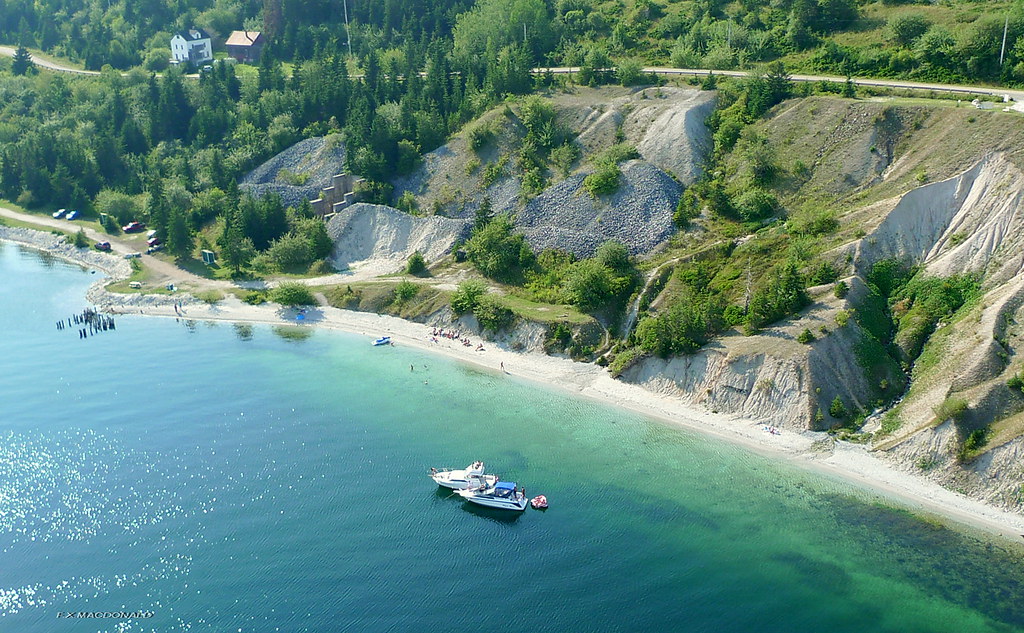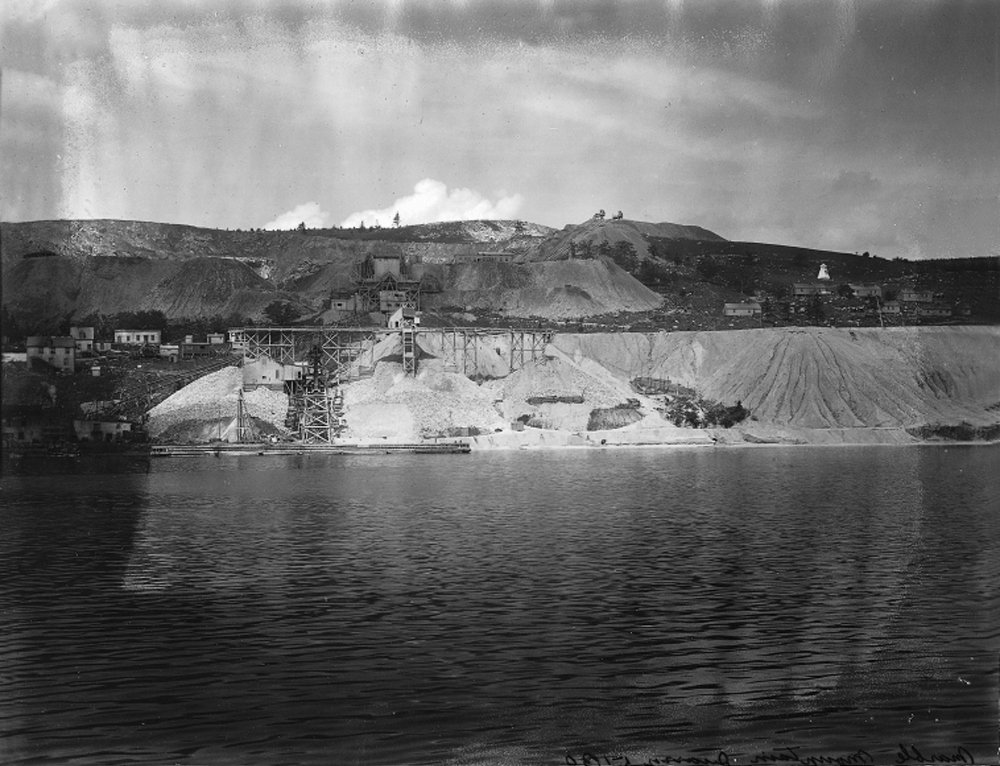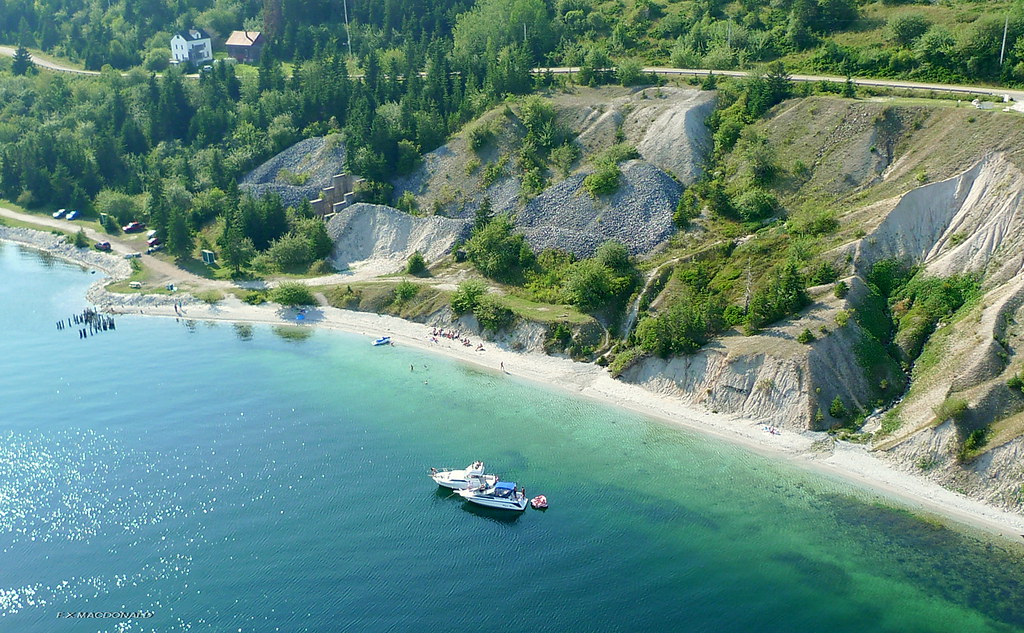It looks like a tropical paradise but it's actually #CapeBreton's #MarbleMountain! Its white sand beach and turquoise water are the result of a marble quarry that started operating there in 1869.
Here's the story of this beautiful site!
#nspoli #cbpoli #novascotia @AllanMacMaster
Here's the story of this beautiful site!
#nspoli #cbpoli #novascotia @AllanMacMaster

Crushed stone was pulled into the water by waves, making the beach white.
Because marble has high pH, it keeps the water at #MarbleMountain soft and clear. This lets you see the white sand underneath better, making the water look turquoise.
#nspoli #cbpoli #novascotia #capebreton
Because marble has high pH, it keeps the water at #MarbleMountain soft and clear. This lets you see the white sand underneath better, making the water look turquoise.
#nspoli #cbpoli #novascotia #capebreton

In fact, the marble's pH offsets damage from acid rain and helps keep the entire Bras D’Or Lake healthy.
In 1868, Nicholas Brown of Prince Edward Island happened upon a substantial marble outcropping in the area.
#nspoli #cbpoli #novascotia #capebreton

In 1868, Nicholas Brown of Prince Edward Island happened upon a substantial marble outcropping in the area.
#nspoli #cbpoli #novascotia #capebreton


He acquired the mineral rights and started quarrying marble and limestone the following year.
He called the area #MarbleMountain to help promote his business and was responsible for establishing the post office that officially proclaimed Marble Mountain’s existence May 1, 1871.
He called the area #MarbleMountain to help promote his business and was responsible for establishing the post office that officially proclaimed Marble Mountain’s existence May 1, 1871.

Brown passed away in 1879 and in 1885 the site was purchased from the Sheriff of Inverness by the Bras d'Or Lime and Marble Company.
In the 1800s, the marble was quarried for two purposes: 1) A grey marble extracted from the lower quarry was heated to produce...
#nspoli #cbpoli
In the 1800s, the marble was quarried for two purposes: 1) A grey marble extracted from the lower quarry was heated to produce...
#nspoli #cbpoli

...white lime for the construction and agricultural industries; and 2) large blocks of white marble were extracted from the upper quarry and two adits (tunnel openings), lowered down the hill to a mill at the wharf where the stone was cut into slabs for use as...
#nspoli #cbpoli
#nspoli #cbpoli

...building and monument stone.
Sample blocks of the marble were displayed at the 1876 Centennial Exhibition in Philadelphia, the first world’s fair hosted by the United States. According to an 1877 government report, they were “much admired.”
#nspoli #cbpoli #novascotia
Sample blocks of the marble were displayed at the 1876 Centennial Exhibition in Philadelphia, the first world’s fair hosted by the United States. According to an 1877 government report, they were “much admired.”
#nspoli #cbpoli #novascotia

The marble was said to have excellent texture + quality. “It works freely, takes a good polish, stands the weather well, and is especially adapted for monuments or ornamental work.” The stone had few faults or cracks so very large, solid slabs could be cut, perfect for building. 

Unfortunately, the US imposed a tariff of fifty cents per cubic foot on all foreign marbles in that era so the American market was not open to Canadian producers.
About 8,000 barrels of lime were produced in 1873 and 5000 barrels in 1874, valued at $1.00 per barrel.
#nspoli
About 8,000 barrels of lime were produced in 1873 and 5000 barrels in 1874, valued at $1.00 per barrel.
#nspoli

24 tons of marble were quarried in 1875 and sent away as samples, and about 4,100 tons of limestone were shipped to Prince Edward Island.
In 1895 the Bras D'Or Marble Company said it had “channeled eight floors, each floor containing about 4000 cubic feet of marble...
#nspoli
In 1895 the Bras D'Or Marble Company said it had “channeled eight floors, each floor containing about 4000 cubic feet of marble...
#nspoli

...or about 32,000 feet over all.” Among the equipment the company had on-site was a “lowering gear, for lowering any size block of marble up to twenty tons, down the incline from quarry to mill, which is at the wharf.
#nspoli #cbpoli #novascotia #capebreton
#nspoli #cbpoli #novascotia #capebreton

This incline is 1100 feet from quarry to mill, and has a fall of 284 feet. The loaded car going down brings the empty one up.”
During the 1895 season there were 5000 tons of limestone quarried, about 350 tons of marble shipped and 1800 barrels of lime produced.
#nspoli #cbpoli
During the 1895 season there were 5000 tons of limestone quarried, about 350 tons of marble shipped and 1800 barrels of lime produced.
#nspoli #cbpoli

Unfortunately, the closing of the St. Peters Canal for repairs during the shipping season limited the company’s progress.
The 1896 Nova Scotia Department of Mines Annual Report said 2082 tons of marble were produced that year and that...
#nspoli #cbpoli #novascotia #capebreton
The 1896 Nova Scotia Department of Mines Annual Report said 2082 tons of marble were produced that year and that...
#nspoli #cbpoli #novascotia #capebreton

...“The front of a building erected in #Halifax this year shows its adaptability for architectural purposes." (This was presumably a reference to the Wright Building on Barrington Street in Halifax, now called the Marble Building.
#nspoli #cbpoli #novascotia #capebreton
#nspoli #cbpoli #novascotia #capebreton

It was designed for George Wright, a successful catalogue and directory publisher who died in 1912 on the #Titanic.)
The Dominion Steel Company (DOSCO) purchased #MarbleMountain in 1902 and for the next 20 years it produced crushed limestone...
#nspoli #cbpoli #novascotia
The Dominion Steel Company (DOSCO) purchased #MarbleMountain in 1902 and for the next 20 years it produced crushed limestone...
#nspoli #cbpoli #novascotia

..which was used as a flux in the company's Sydney steel plant. (Flux is used in the smelting process to promote fluidity and remove impurities in the form of slag.) DOSCO stopped quarrying Marble Mountain when it developed a new source of limestone in Port au Port, Newfoundland. 

In the early 1900s, over one thousand people worked at #MarbleMountain’s quarries and the village had two churches, seven stores and a branch of the Royal Bank of Canada.
#nspoli #cbpoli #novascotia #capebreton
#nspoli #cbpoli #novascotia #capebreton

It even had its own power station to provide electricity for the quarry, which meant most residents of the little community had electric lights when the rest of rural Cape Breton was still using candles and oil lamps.
#nspoli #cbpoli #novascotia #capebreton
#nspoli #cbpoli #novascotia #capebreton

After 1921, the quarry sat idle for 40 years, until it was reopened by #MarbleMountain Quarries Limited in 1961. The president of the company was Lester E. Hubley who was also president of the Nova Scotia Sand and Gravel company.
#nspoli #cbpoli #novascotia #capebreton
#nspoli #cbpoli #novascotia #capebreton

He acquired #MarbleMountain to quarry and market the marble and crushed rock, which he did for over 2 decades. Hubley also started the first sand and gravel barging operation in #StMargaretsBay and was a founding partner of Hubley Centre...
#nspoli #cbpoli #novascotia #capebreton
#nspoli #cbpoli #novascotia #capebreton

the shopping area in #Tantallon that bears his name.
There have occasionally been tests and small-scale extraction at #MarbleMountain but no significant production since Hubley’s companies stopped working there.
#nspoli #cbpoli #novascotia #capebreton
There have occasionally been tests and small-scale extraction at #MarbleMountain but no significant production since Hubley’s companies stopped working there.
#nspoli #cbpoli #novascotia #capebreton

However, it is estimated there may still be about three million tons of marble at the site.
Another landmark built with marble from #MarbleMountain is the mansion on #Halifax’s Young Avenue often referred to as Oland Castle.
#nspoli #cbpoli #novascotia #capebreton
Another landmark built with marble from #MarbleMountain is the mansion on #Halifax’s Young Avenue often referred to as Oland Castle.
#nspoli #cbpoli #novascotia #capebreton

It was originally built by Alexander Hobrecker who emigrated from Germany to #NovaScotia in 1874 and made his fortune as a tobacco wholesaler. By 1899, Hobrecker was also vice-president of the Bras d'Or Marble Company so he used its marble to build the mansion in 1901.
#nspoli
#nspoli

(During WWI it was rumoured, but never proven, that the house was intended to be the home and headquarters of Kaiser Wilhelm II if he fled to Canada.)
The Oland family bought it in 1927.
#nspoli #cbpoli #novascotia #capebreton
The Oland family bought it in 1927.
#nspoli #cbpoli #novascotia #capebreton

• • •
Missing some Tweet in this thread? You can try to
force a refresh



























